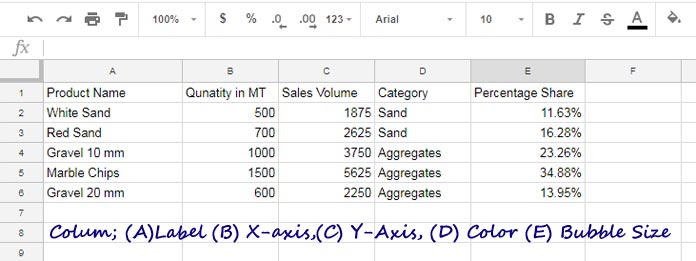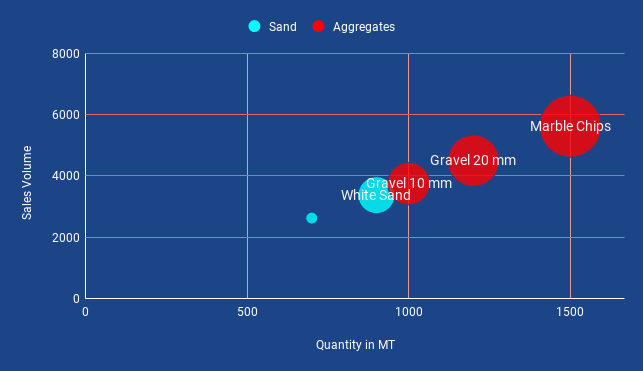With the help of this tutorial, you can quickly learn how to create a Bubble Chart in Google Sheets.
In a Bubble Chart, the data points resemble bubbles. You can control the size of them.
I mean, you can keep it the same size or different sizes.
You might have already read that the Bubble Chart has some similarities with the Scatter Plot. It’s true to some extent. But both are visually different.
In both the charts, your Spreadsheet data is displayed as a series of points on the graph.
Unlike Scatter, the Bubble Chart has one additional dimension to control the data point/bubble size.
Understanding how to format the data for the Bubble Chart in Google Sheets is the simplest way of understanding this one of the most popular Charts.
To create a Bubble Chart in Google Sheets, you can follow the below tips. It covers how to format the data and essential Chart customization tips.
Data Formatting in Five Columns
Just like the Scatter, here also, the horizontal and vertical axis values are numbers. Let me begin with the most important part, i.e., data formatting to create a Bubble chart in Google Sheets.
There are five columns in the below sample data, and they are columns A, B, C, D, and E (please refer to the image below). Here are their purpose.
- “Product Name”: It is the labels to show up inside the bubbles.
- “Quantity in MT”: The X-axis values.
- “Sales Volume”: Y-axis values (the series points/bubbles).
- “Category”: Category of “Product Name.” It determines the color of the bubbles/series points. The same category will have the same color. This column also acts as the legends in the chart.
- “Percentage Share”: It controls the bubble size.
The below is my five-column sample data to create the bubble chart in Google Sheets. Please note that all the columns other than columns B and C are optional.

I hope I have clearly explained how to format data for the Bubble Chart in Google Sheets.
Before going to more details, please take a look at the finished Bubble chart below.

How to Create a Bubble Chart in Google Sheets
The first step to create a Bubble Chart in Google Sheets is to format the data as above.
In that, you may have doubts about columns five and six, which control the bubble color and sizes, respectively.
How to Color the Bubbles (Data Points) Group-wise in Bubble Chart in Google Sheets?
The answer is there itself in the question. You can determine how many colors you want by changing the group/category in column D.
In my example, I have two types of materials, and they are Sand and Aggregate. So I have two colors in the Chart.
How to Change Bubble Size in Bubble Chart in Google Sheets?
You can determine the size of the Bubbles in the Bubble Chart. Usually, the fifth column in the source data controls the bubble size.
Can I Get Unique and Small Bubble Sizes like the One in the Scatter Plot?
Why not? Just put any unique numbers in Column E. Any number but all the cells should have the same number.
I mean, in my example, I can fill the range E2:E6 with the number 1 and cell E7 (a helper cell) with the number 2 to get unique bubble sizes.
What are the current percentage values in Column E?
I have this formula in cell E2, which dragged down.
=C2/sum($C$2:$C$6)I hope I have given enough tips to make you understand the Bubble chart better. Now let us move to the next step, i.e., chart creation.
Steps to Create a Bubble Chart in Google Sheets
1. Select the data range A1:E6 (for unique small-size bubbles similar to the scatter plot, select A1:E7 instead).
2. Click on the Menu “Insert” and select “Chart.”
3. Change the Chart type to “Bubble Chart.”
Apply the Below Basic Customizations
The below customization options are available under the CUSTOMISE tab of the Sheets Chart Editor.
1. Under “Horizontal Axis,” change the “Min” number to 0.
2. Similarly, under the “Vertical Axis,” change the “Max” number to 8000.
3. Then look for “Bubble”. There, you can change the color of the grouped Bubbles.
That’s all. Follow the above steps to create a Bubble Chart in Google Sheets.
Resources:





















